The mysterious 'magic' of microbes: Tiny life forms could unlock secrets about our world
TUCSON — It’s a hot and sticky August morning, but that won’t stop a group of microbiologists on a quest.
They’re looking for some very specific soil in the Santa Catalina Mountains, amid cactus, tarantulas and rattlesnakes. And the monsoon moisture they’d been waiting for has arrived.
The overnight rain in this area between Oracle and Mt. Lemmon means the conditions will be perfect for the scientists to collect the samples they need. Paul Carini, assistant professor of environmental microbiology at the University of Arizona in the Department of Environmental Science, has assembled his team.
It won’t be an easy journey to get to the sampling site. They’ll cross a river and climb through the desert with the goal of collecting soil that might have a certain unique single-cell creature in it. Once they complete their mission, a whole afternoon of hard work in the lab awaits them, and even then, they won’t know for sure if they’ve found what they’re looking for. But Carini thinks the effort will be well worth it.
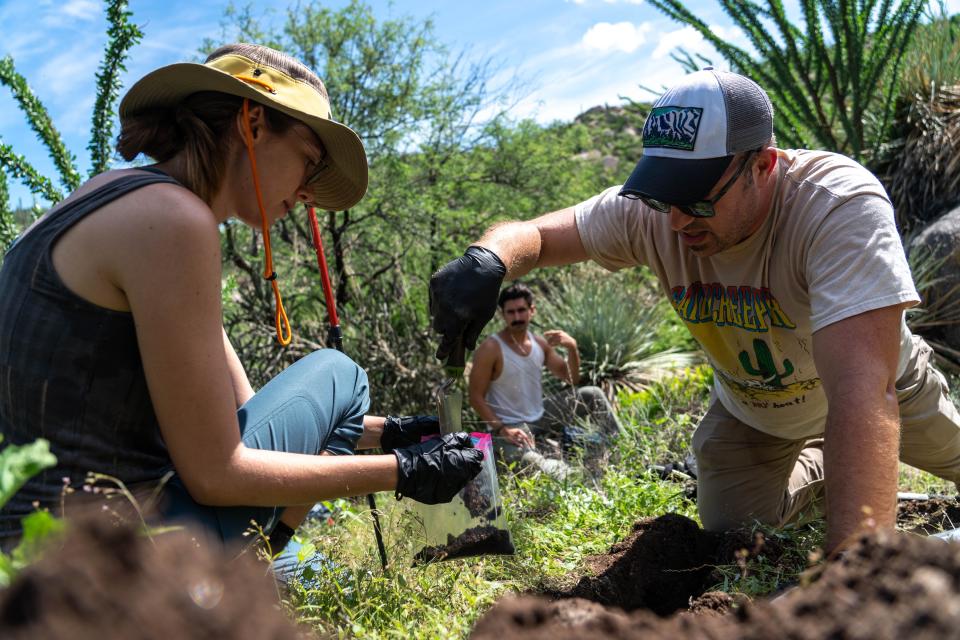
The prize? The chance for a closer look at the tiny, invisible creatures that inhabit nearly every square inch of the Earth’s surface.
Microbes.
In two tablespoons of soil, Carini says, there can be as many microbes — a broad term encompassing mostly single-cell, bacteria-like life forms — as there are people on Earth. In that same two tablespoons, there can be as many species of microscopic life as there are species of birds on the planet.
Some of those microbes can be hundreds of thousands of years old. They can survive without water, nutrients or light. They can lie dormant during droughts and come back to life decades later. In a complex web of interdependent organisms, they perform the chemical processes that form the foundations of life.
It’s mysterious because it’s so understudied, but Carini and others like him hope to change that. That change coincides with a shift in the methods being used to examine these tiny creatures — a “renaissance,” as Carini described it — merging old-school techniques with modern technology.
In Carini’s lab, researchers are combining methods that were used several decades ago with the latest technology. That’s a change Carini sees more broadly in the world of microbiology research.
They aren’t just doing this for fun: Carini hopes that better understanding microbes will yield insights that can be applied to help us weather the worst effects of climate change. That could be vital information as Arizonans face water cuts and farmers around the world look for ways to provide for a growing population in harsher biological circumstances.
While some botanists study plants to look for ways to make them better able to cope with drought, Carini thinks microbiologists can contribute by studying the relationship between plants and microbes, and the evolutionary tricks that microbes use to survive long periods without water and to coexist with their botanical companions.
Someday that might mean we start putting specific microbes in the soil to help a crop grow in conditions it couldn’t survive otherwise.
But the researchers won’t know for sure whether those kinds of applications will pay off in the long run until they do basic science experiments to observe the tiny organisms in question.
8:33 a.m.
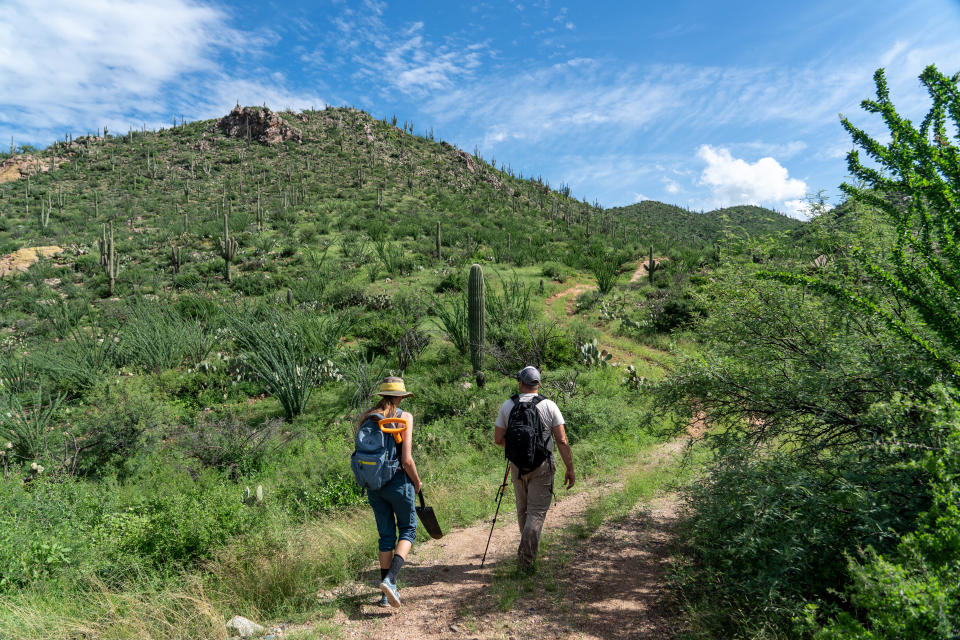
The scientists gather on a sloping road in the Saddlebrooke retirement community, at a spot designated by a purple Port-a-Potty and four yellow-and-black-striped bollards. Below the bollards, the land dips sharply into a tumble of foliage that has cropped up on the slope.
Carini says he’s never seen this place look this green.
He sports a T-shirt promoting a Tucson heavy metal band, emblazoned with the classic Arizona phrase, “It’s a dry heat” — not exactly true on this humid day. He laces up his boots and extends his lightweight trekking poles.
Along for the day are Alexander Ederer, a doctoral student at UA who’s used to difficult hikes for his own research, and Izzy Viney, a graduate student in Carini’s lab. At Ederer’s recommendation, Viney doubles back to switch out her shorts for longer pants, a necessity while trekking through mostly uncharted desert territory full of scratchy and spiky plants.
Why contend with all of nature’s toughest defenses? Besides the potential scientific payoff, for Carini personally, the search for treasures beneath the surface has been a lifelong interest.
Growing up in Wisconsin, he would cross his backyard to the back of a nearby tavern where patrons threw their trash into an empty lot. There, he would dig in the soil. Chicken bones, in his young imagination, became dinosaur bones. Once he even found the skeleton of a squirrel.
“I associated digging holes in dirt with discovery at a pretty young age,” he says.
After exploring a couple of other possible careers (for a while, Carini wanted to be a race car mechanic), he settled on microbiology. The discipline was always there, with ample uncharted territory to explore.
Now, he prepares the snake bite kit and first aid supplies, and reminds the group of basic safety procedures.
Then it’s time to go. It’s only going to get hotter, and another storm looms on the horizon.
9:16 a.m.
The researchers trek out of sight of their cars, under a barbed wire fence and past a large boulder that they use as a landmark. They arrive at the river.
The monsoon rains have turned this normally dry creek bed into a rushing torrent filled with sediment. Nevertheless, the researchers cross without hesitation.
The water soaks through their pants and shoes, which squelch as the team climbs up on the other bank.
This water-logged path is out of the ordinary. About a third of the land on Earth is in an arid or semi-arid ecosystem, and this part of Arizona falls squarely into the semi-arid category, meaning that a lot of the time, there isn’t much water to speak of, much less fill up a pair of hiking boots.
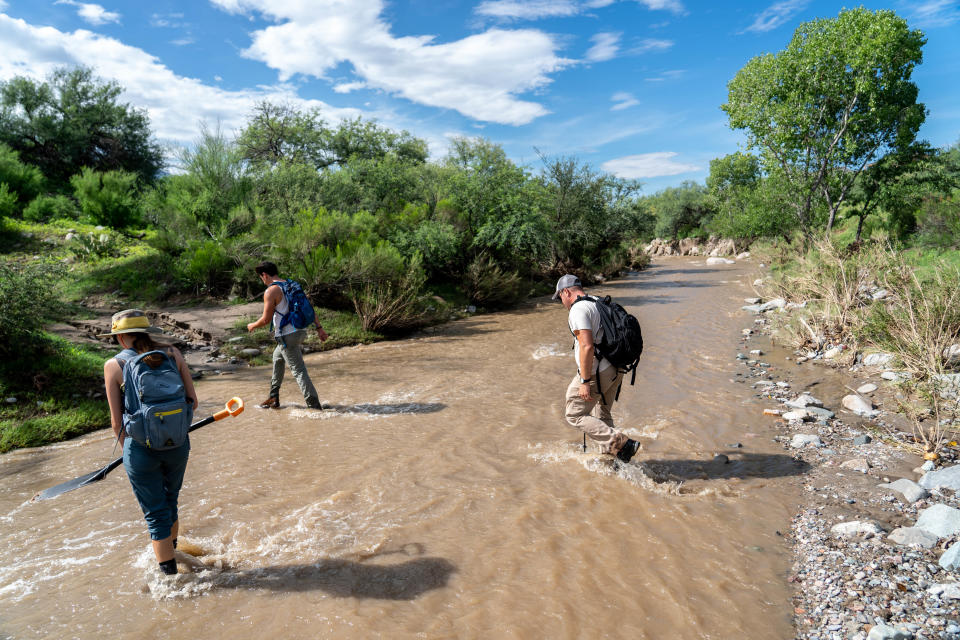
That’s part of what interests Carini about the microbes in this area. They are fascinating for their resilience in a harsh environment, and their behavior could shed light on changes happening all around the world, before those changes even happen.
“Water distribution patterns are shifting all over Earth. Places that didn't get a lot of rain previously are getting more rain, and places that got sufficient rain are getting less rain,” he says. “The microbes in the soils at those places are responding to those changes.”
As a result, he says, microbial changes could be a “canary in the coal mine” for other organisms.
“(Microbes’) generation times are so small relative to (those of) plants and animals that they're going to shift their physiology and their metabolism before any of those other things are,” he says. “If we can capture that and understand that better and include it in Earth models, we can predict with a greater degree of accuracy how climate change is going to affect chemistry or agriculture.”
And when it comes to agriculture, pinning down exactly what each type of microbe does could be revolutionary. Certain crops like corn and soy have already been documented to have close relationships with microbial organisms that can affect yields.
Carini isn’t the only one interested in the implications for agriculture. Paul Dijkstra, a research professor in the Center for Ecosystem Science and Society at Northern Arizona University, thinks a better understanding of soil health could allow for humans to improve growing conditions for all kinds of crops.
“It wouldn't surprise me if we start thinking about manipulating the soil so it's more healthy or plants grow better on it or something like that,” said Dijkstra, noting that that possibility, while innovative, might not be the wisest choice ecologically. “But we're very far away from that — at least 10 years away from the first experiments, probably.”
Carini said he hopes his contributions will add to the foundation of basic science necessary for those experiments to occur. But first, he has to get to the top of the hill.
9:45 a.m.
So up they go. They pick their way over large boulders and around cactuses. A deer trots along the ridge in the distance.
They stop to hydrate. A large insect with a bright red bottom scoots across their path. Tadpoles wriggle in the ponds that formed overnight between the thick slabs of rock, and toads no bigger than fingernails launch themselves into the water.
Carini has studied lots of different kinds of microbes, but it’s here in Arizona that he’s found his niche. He investigated microscopic open-ocean life in graduate school (and quickly discovered his propensity for seasickness). He’s worked on several other field sites that involved various degrees of hiking, shoveling and other outdoor data collection.
But the wildest field trip so far, he says, was the day before, in preparation for this outing. He and Ederer went out by themselves to find the data collection site and promptly got lost. Ederer had a near miss with a rattlesnake, and Carini stumbled and fell into one of the natural pools they’re hiking along today.
That trip smoothed out some of the wrinkles ahead of time, and now it’s one foot in front of the other.
Ederer expresses his appreciation for the downloaded GPS system. They’re all exerting themselves today, but at least they know where they’re going.
10:30 a.m.
Everyone is sweating by the time they find what they’re looking for: a patch of ground that, to the untrained eye, looks no different than everything else on the slope.
But a small divot in the ground reveals why this place is special: The team sampled here two years ago, and because of that, they know where in the layers of soil they might find the organisms they’re targeting.
Ederer sits on a shaded rock to rest while Carini crouches and unzips his pack. He pulls out a pair of latex gloves, then wrestles his damp hands into them.
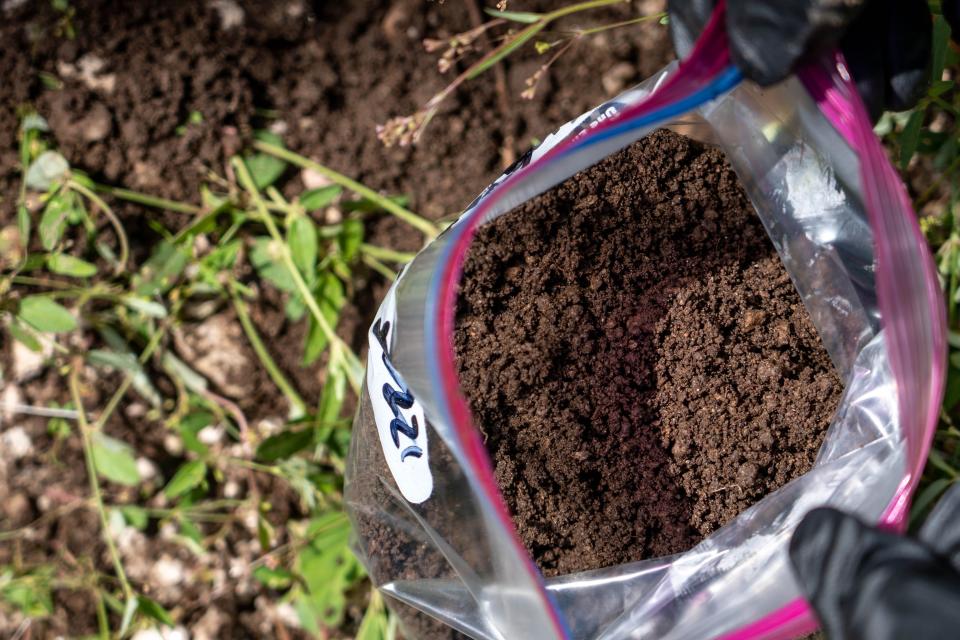
The gloves are supposed to help keep the soil samples sterile, though Carini concedes that many microbiologists feel ambivalent about the concept of sterility when sampling soil simply because there are so many microbes in the soil that the number of microbes that live on us are negligible in comparison.
Now it’s time to dig the pit.
He picks up the shovel, pushes his foot into it and pulls up a thick pile of deep brown soil.
The scientists are amazed. Last night’s rains have made their job much easier than they expected.
“I didn’t know soil could be that dark in the desert,” Ederer says. “I mean, you went a whole blade’s (length) deep in one go.”
“Oh my God,” Carini says. “This is glorious.”
Carini makes quick work of the rest of the pit, which is roughly two feet long and three feet deep. They stop briefly to admire the discard pile.
“It smells kind of sweet,” Viney says.
They breathe in deeply. Using a trowel, they notch out soil samples at 10-centimeter increments and pour them into pre-labeled Ziploc bags.
Carini stuffs the six bags of soil into his backpack. They’re ready to get back to the lab.
10:49 a.m.
When they do, they won’t see much more than what they can already see in those bags of soil. Even if they were to look at the microbes under a microscope, Carini says, they wouldn’t notice much more than tiny circles or other roundish shapes.
Instead, the techniques they use rely on chemistry to observe the organisms’ characteristics. Just like plants have adapted with spines or broad leaves that help them handle particular ecological challenges, Carini thinks microbes might have similarly adapted in ways we don’t know about yet.
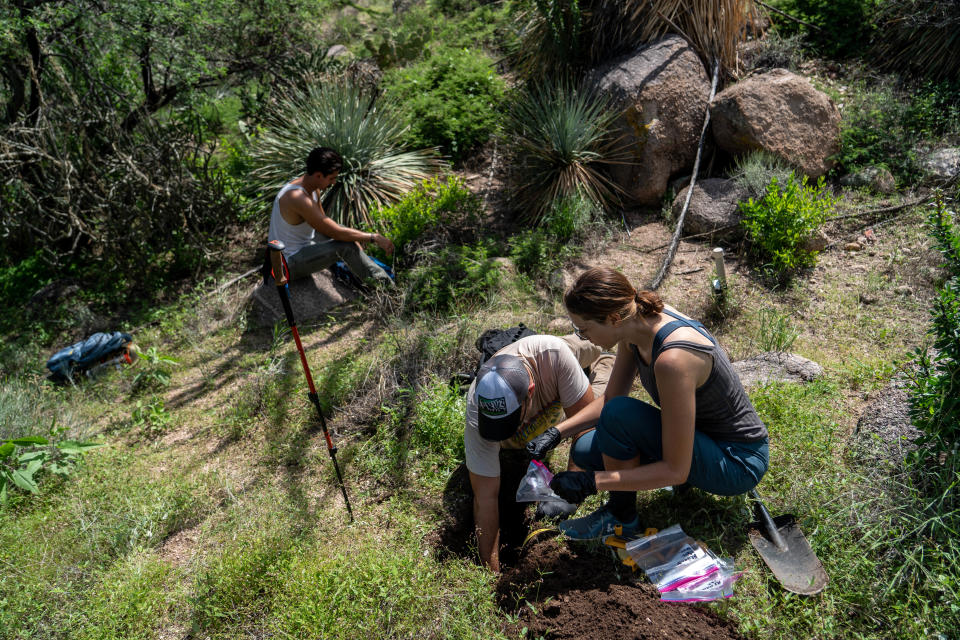
Maybe they won’t be directly observable, like cactus spines, but by studying their chemical composition over time in the lab, the researchers might unveil something new about how these microbes work.
“What we’re doing is kind of like magic,” he says. “We can’t actually see anything we work with.”
As they hike back down the hill, Carini describes the different ways scientists have studied microbes, even though the tiny life forms are invisible to the naked eye.
In the past, he says, the researchers predominantly used a method called culturing. If microbiology had a stereotype, that would be it: collect some organisms, plop them in a petri dish and watch them grow.
Carini compares this method to listening to music on a record player. Culturing involves an analog format that you can keep around for decades, and you’re actually raising live creatures. It’s a physical, tangible, organic process.
In recent years, he says, some microbiologists made a switch. They started using sequencing technology, cataloging genetic material with a combination of pipettes and computers, much the same way COVID labs track variants of the coronavirus.
That method is akin to digitally streaming music. You might play the same song, but it doesn’t capture the richness of sound like a record player. And if every computer on Earth stopped working tomorrow, you wouldn’t be able to access your samples like you could with cultures.
Nowadays, some microbiologists like Carini advocate for a combination of the two techniques, analog and digital. He thinks culturing captures some microbial activity that cannot be studied by their DNA alone. Some of these micro-creatures are more finicky than others, but keeping them alive in the lab is worth it, he says.
And now, when many members of the general public know about genetic sequencing and are more interested in the trillions of tiny entities with which we share the planet, Carini hopes that combining those techniques will lead to breakthroughs.
When they get back to the cars, Carini pulls out a cooler of Gatorade and water. Everyone needs it.
1:09 p.m.
The scientists can’t bring the samples straight to the lab. There’s a strict no-soil policy up there, because soil mites could easily ruin an experiment.
Instead, they haul their loot down to a basement room overflowing with scientific equipment. Boxes and beakers line the shelves. A large rack houses several shovels and the refrigerators are stocked full of old soil bags. In one corner, there’s a fume hood; in another, a sink; in another, precise scales used to weigh even the smallest of samples.
Some other students have arrived to help, so Carini shows them what to do. First they sanitize a brass sieve and filter some of the soil from one of the Ziploc bags. Then they use a tool similar to a palette knife to measure out precisely 10 grams on a weighing boat, a small dish used to portion samples.
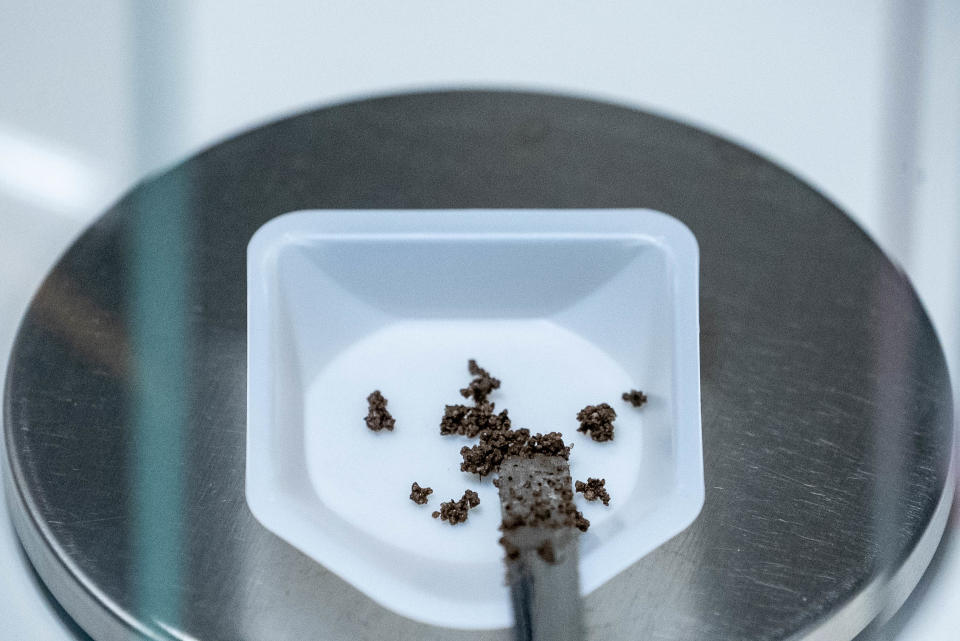
Finally, they dole out itty-bitty grains into bottles that are color-coded with information about what depth the sample was taken and what solution the sample is being put into.
Also on hand to assist is Oona Snoeyenbos-West, a staff research scientist in Carini’s lab who has not one but two doctorate degrees. She describes the COVID-19 pandemic as a “zeitgeist moment” that sparked public interest in all kinds of tiny worlds, from fungi that can degrade plastic to medical applications of the human microbiome.
“It’s a microbial world,” she says. “We are made of microbes.”
Right now, though, she’s particularly fascinated by the biogeochemical cycles and diversity of the microbes that live deep beneath the Earth’s surface. Researchers have just scratched the surface of knowing what microbes are doing and just beginning to ask some questions about their roles in shaping our planet.
Life, after all, transforms the environment it lives in.
“They’ll be here after we’re gone,” she adds. “I think the microbes are running the show.”
She finishes loading up the little vials. They’re ready for the experiment upstairs.
2:03 p.m.
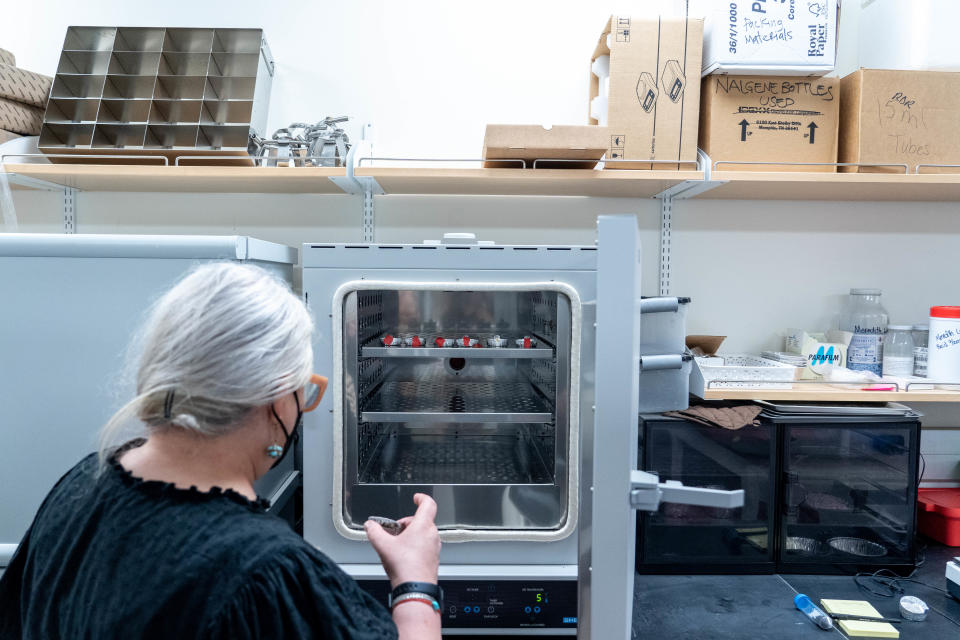
Time to see what the microbes are up to.
In this experiment, Carini and his team are looking for a specific type of single-cell organism called archaea. To examine what’s going on, they’re going to add a concoction of chemicals that can detect whether the archaea are growing by looking for the presence of nitrite, a particular compound that’s a byproduct of their growth. If there’s nitrite, that’s a good sign that the archaea are in the samples.
First the painstaking process of pipetting into tiny wells. The tray goes into a drawer so one of the light-sensitive ingredients can stay in the dark for a few minutes.
They wait.
2:21 p.m.
More pipetting. Back into the drawer.
They wait.
2:33 p.m.
Now they can put the little plastic tray into a plate reader, a machine that’s kind of like a VCR for microbiologists. They insert the tray into the slot and a computer does a sophisticated scan of the exact color of the solution in the wells.
The wells will turn pink if there’s any nitrite, so the pinker the scan, the more nitrite there is.
2:43 p.m.
Now, the moment of truth. They put the wells into the machine and press a button. Numbers start popping up on the screen.
Carini and Snoeyenbos-West look at each other excitedly.
Nitrite!
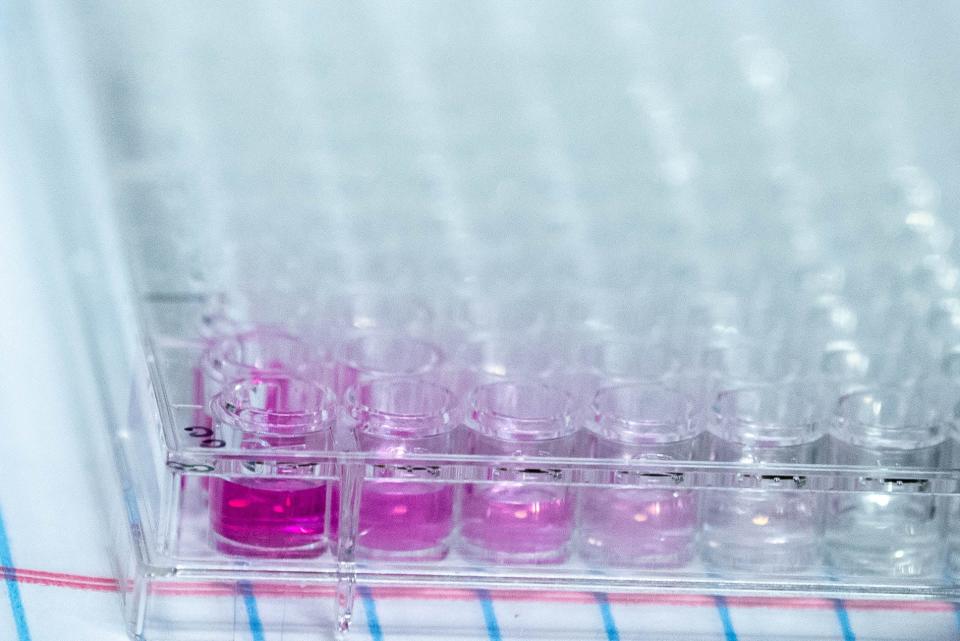
It’s in very small amounts, but it’s there, in some of the wells. Carini says it will take several more tests to chart out how it changes over time. If the archaea are in there, more nitrite will start to appear.
Even after their hours of hard work, this is just the beginning. It will take weeks more of precise analysis and number crunching to know if they’ve found anything meaningful here.
But for now, the team is excited. Their day of hard work has paid off. That’s not always a given. In science, there are so many ways for things to go wrong.
“In real life, you fail 90% of the time,” Carini says.
That’s a hurdle that his students have to get over. Some never do.
“But you get used to it,” Carini adds. “People paying attention to the small details, one microliter of this, one microliter of that — they all add up to success at some point.”
And that’s why they keep going back, collecting data, and trying again.
One microscopic step at a time.
Independent coverage of bioscience in Arizona is supported by a grant from the Flinn Foundation.
Melina Walling is a bioscience reporter who covers COVID-19, health, technology, agriculture and the environment. You can contact her via email at mwalling@gannett.com or on Twitter @MelinaWalling.
This article originally appeared on Arizona Republic: University of Arizona scientists go to great lengths to study microbes

